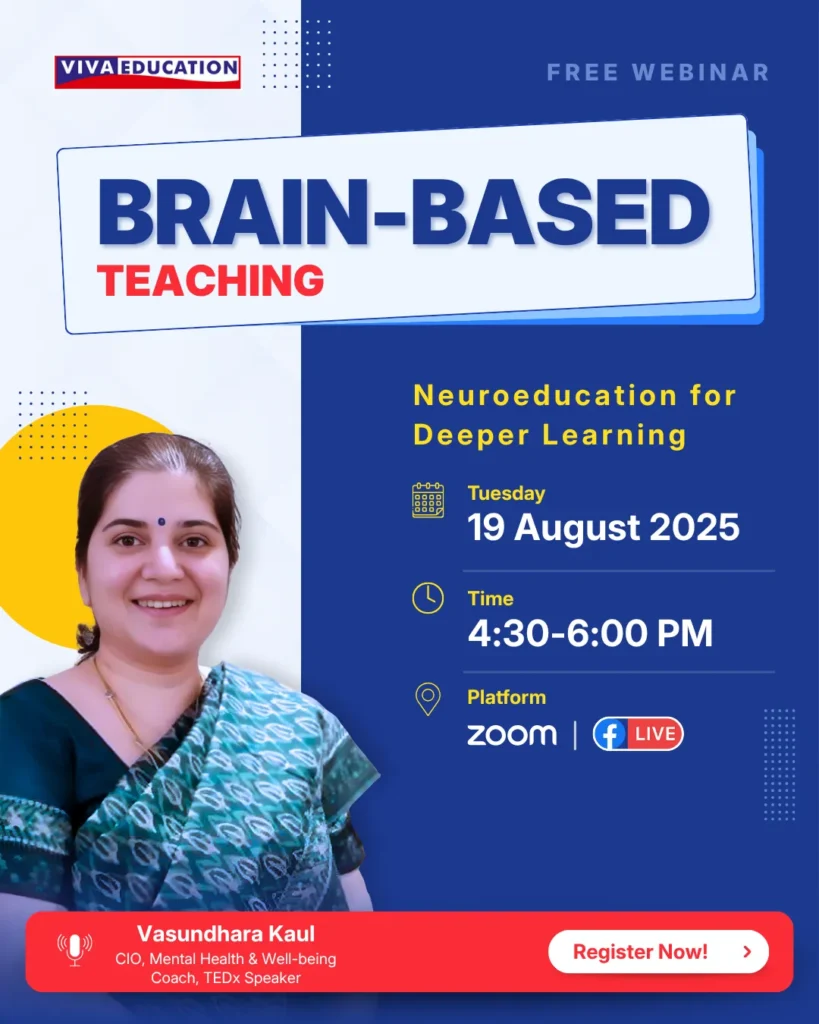Brain-Based Teaching: 5 Practical Approaches for Today’s Educators
- Teachers
- August 8, 2025
- Viva Education

Educators are always pressed for time.
Between completing the syllabus before exams, handling administrative duties, managing large class sizes, and most teachers are left scrambling. Add in traditional teaching methods, pressure from school management, and the challenge of catering to diverse learning levels, and the result is clear: very little time for meaningful, deep learning.
Yet, that’s precisely what students need.
In the wake of widespread learning loss, especially in classrooms with limited facilities, every moment of engaged learning has become more valuable than ever. Teachers don’t just need more hours; they need proven, practical strategies that make their limited teaching time count.
This is where brain-based teaching comes in. Backed by neuroscience, this approach helps you align your teaching with how students’ brains naturally absorb, retain, and apply knowledge, without sacrificing creativity, flexibility, or personal connection.
In this article, we’ll explore five powerful, easy-to-apply strategies that work in classrooms, whether you’re teaching CBSE in Delhi, State Board in Tamil Nadu, or ICSE in Mumbai. And for those who want to go deeper, we invite you to a free Viva Education Webinar where you’ll learn how to apply these tools the right way.
What is Brain-Based Teaching?
Brain-based teaching is an instructional approach grounded in neuroscience, designed to align with how the brain naturally learns, processes, stores, and retrieves information.
Instead of relying on traditional methods like passive lectures and rote memorisation, brain-based teaching uses what we know about attention, memory, motivation, and emotion to make learning more effective and engaging. It encourages practices like movement, hands-on activities, real-world connections, frequent brain breaks, and emotionally supportive environments. The goal is simple: help educators teach smarter, not harder, by working with the brain’s natural processes, not against them.
Principles of Neuroeducation
Neuroeducation blends neuroscience, psychology, and education to inform teaching practices grounded in how the brain learns and grows. It emphasises that learning is first emotional, then cognitive; students must feel safe and supported before they can meaningfully engage.
Core principles include:
- Neuroplasticity:
One of the most exciting discoveries in neuroscience is that the brain remains adaptable throughout life. This is known as neuroplasticity, the brain’s ability to rewire itself based on new experiences and learning. Every time a student learns something new, their brain forms fresh neural connections. Even students who’ve fallen behind can improve significantly when we provide consistent, varied, and supportive learning experiences. With the right strategies, every child, regardless of background, can grow academically.
- Emotion and Engagement:
Before students process facts, they process feelings. Emotions directly affect attention, memory, and motivation. A positive emotional state enhances the brain’s ability to retain information, while fear, shame, or stress can block learning altogether. When a student feels safe, supported, and emotionally invested, they’re more likely to engage deeply. Storytelling, humour, and relatable examples trigger emotional engagement and, therefore, deeper learning.
- Meaningful Connections:
Students learn more effectively when new concepts are connected to something they already know or something personally meaningful. Linking lessons to real-life experiences, such as comparing maths problems to cricket scores or using local examples in geography, creates stronger memory pathways. It transforms abstract content into something practical and memorable.
- Active Learning:
Passive learning, like sitting through long lectures, activates very little of the brain. In contrast, active learning sparks multiple brain regions by combining physical, emotional, and intellectual engagement. Activities like group discussions, role-play, drawing, modelling, or peer teaching deepen understanding and support long-term memory. Even short tasks where students reflect, speak, or build something can dramatically improve retention.
- Social Interaction:
Social learning through collaboration, dialogue, and peer feedback activates the brain’s language, empathy and problem-solving centres. When students learn together, they learn more effectively. Teamwork encourages perspective-taking, communication skills, and mutual motivation. It’s especially helpful for students who may struggle in isolation but thrive in peer-supported settings.
- Safe and Inclusive Environment:
Creating a safe, inclusive, low-pressure environment is not optional; it’s foundational. Praise effort over perfection, allow space for mistakes, and foster a classroom culture where every student feels seen and respected.
When educators apply these principles, they create classrooms that are not only academically rigorous but also emotionally intelligent, inclusive, and empowering.
5 Brain-Based Teaching Strategies That Actually Work
Below are five practical, research-backed brain-based teaching strategies that you can implement immediately, even in a packed, noisy, time-crunched classroom.
1. Break Big Ideas Into Smaller Parts
The brain isn’t built to absorb everything at once, especially when learning something new. That’s why traditional, non-stop lectures often fail.
Brain-based teaching uses cognitive chunking, breaking lessons into smaller, digestible sections. Instead of tackling an entire topic in one go, you guide students through bite-sized inputs followed by quick, active tasks like drawing from memory or peer discussions.
For example, teaching the water cycle? Begin with a diagram, followed by a discussion, and conclude with a short activity and recap. This method respects the brain’s capacity, leading to better retention and understanding, without overwhelming students.
2. Use Movement to Boost Focus
Stillness can stall learning. When students sit for too long, their attention and energy tend to dip. Studies have shown prolonged sitting can result in a shrinkage in brain size, impacting the overall brain development.
Movement, on the other hand, energises the brain, increasing oxygen flow and triggering focus-boosting chemicals like dopamine. With brain-based teaching strategies, movement isn’t a distraction; it’s a tool. You can introduce “brain breaks” every 15–20 minutes: quick stretches, movement-based games, or walking discussions. Even older students benefit from this. One brain-based learning example?
A teacher had students act out photosynthesis using their bodies, leaves, sun, and roots. The result? Higher engagement and deeper retention. The takeaway: if students move, their minds move too.
3. Make Students Recall What They Learn
Memorising by reading or repeating doesn’t guarantee long-term learning. Our brains work by retrieving knowledge, not just storing it.
That’s why retrieval practice, actively recalling information, is one of the most effective brain-based teaching strategies. Instead of reviewing notes endlessly, ask students to recall facts through low-stakes quizzes, memory maps, or peer teaching. For example, start class with “What do you remember from yesterday?” or have students draw concepts from memory.
Replacing revision sheets with teach-backs led to a dramatic spike in test scores, proof that student-led learning sticks. Retrieval makes the brain work harder, strengthening memory pathways and deepening understanding.
4. Connect Lessons to Real Life
Students remember what feels meaningful, and the brain flags relevance as necessary. Abstract concepts alone don’t stick, but when you link them to real life, learning becomes memorable.
That’s what brain-based teaching encourages, making content emotionally and culturally relevant. Use everyday examples, percentages via shopping budgets, gravity through cricket, or distance-time through local train travel. These connections help students relate new concepts to what they already know.
One brain-based learning example involved teaching speed using real train schedules, and the students remembered the formula long after. Real-life application isn’t a luxury; it’s how the brain learns best.
5. Help Students Feel Safe to Learn
Brains under stress don’t absorb well. When students feel anxious, judged, or unsafe, the amygdala takes over, shutting down the parts of the brain that manage memory, focus, and reasoning. That’s why creating a supportive classroom is a brain-based teaching essential.
Celebrate progress, not perfection. Start the week with affirmations or “wins”. Make space for emotions without judgment. A teacher began each Monday with a journal prompt about one positive thing from the past week. The result? Students felt calmer, more confident, and ready to engage. A safe learning space isn’t soft, it’s smart. Because safe brains learn better.
Brain-Based Teaching for Deeper Learning
If you’ve found these strategies helpful and are ready to take your teaching practice to the next level, don’t miss our upcoming free webinar:
This interactive session will equip educators with tools grounded in neuroscience, covering how to apply brain-based teaching strategies across all curriculum types, from CBSE and ICSE to State Boards. You’ll walk away with fresh, classroom-ready methods, brain–based learning examples, and an understanding of how to use emotion, repetition, and real-life relevance to supercharge your lessons.
Why This Webinar Matters
Led by Vasundhara Kaul, a TEDx speaker and Chief Innovation Officer at Carpediem EdPsych Consultancy, this session goes far beyond theory. With over 18 years of experience as a mental health practitioner, instructional designer, and educational trainer across India and the UAE, Vasundhara brings a rare blend of neuroscience, empathy, and practicality.
She’ll share actionable methods based on her research and vast experience, strategies that have helped schools, educators, and corporate teams alike. Whether you’re teaching a classroom full of energetic 5th graders or mentoring senior students preparing for boards, this session will show you how brain-based learning can fit into your teaching style and schedule.
This webinar is part of the Viva Education Webinars series, free sessions designed to support educators with tools that work in the real world, not just in textbooks. With education constantly evolving, this is your opportunity to stay ahead and ensure your students learn and thrive.
Seats are limited. Register now to secure your spot and transform how you teach.
Frequently Asked Questions:
1. How can I implement Brain-based teaching strategies in a classroom with a large number of students?
Many of these strategies are well-suited for large classes. For example, “cognitive chunking” can be done by breaking down a lecture into smaller, 10-15 minute segments followed by a quick, active task like a “turn and talk” with a neighbour. Retrieval practice can be implemented with a quick “poll the room” or a low-stakes pop quiz. The key is to use group-based activities and quick, efficient methods that don’t require individual one-on-one time.
2. I have a packed syllabus. Won't brain-based teaching activities take up too much time?
Brain-based teaching is about teaching smarter, not longer. Strategies like movement breaks are brief (just a few minutes) but can dramatically improve focus for the next block of learning. Retrieval practice can be a quick warm-up at the start of class, and connecting lessons to real life can be a simple, one-minute example you use while explaining a concept. The time invested in these short activities often saves time later because students retain information better and require less re-teaching.
3. How do I handle students who are resistant to active learning or group work?
Start with small, low-pressure activities to build comfort. For example, instead of a full-blown role-play, begin with a simple pair-share. The “safe and inclusive environment” principle is crucial here; praise effort, not just the “right” answer. Remind students that making mistakes is a natural part of learning and that the goal is to think, not to be perfect. Over time, as students feel more secure, they will be more likely to participate.
4. Can these strategies be applied to all subjects, including complex ones like science or math?
Yes, absolutely. The principles of neuroeducation are universal. In math, you can use “cognitive chunking” to teach a single concept before moving to the next. For science, “real-life connections” can be made by using everyday examples like cricket to explain physics concepts. Retrieval practice is perfect for all subjects—instead of reviewing notes, ask students to write down the key steps of a formula from memory.
5. How can I incorporate brain breaks without the class becoming chaotic?
Set clear expectations and routines. Start with a structured “brain break,” such as a two-minute stretching session or a pre-planned, movement-based game. Explain to students that this is a tool for refocusing their brains. You can also integrate movement directly into the lesson, such as having students stand up to answer a question or move to different corners of the room to indicate their opinion. This keeps the movement purposeful and controlled.
Share on:




